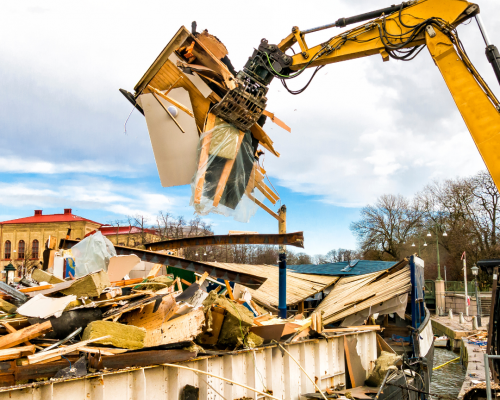DIY Demolition Safety Tips: Protect Yourself and Your Property
Embarking on a do-it-yourself demolition project can be both exciting and daunting. Whether you’re tearing down a wall to create an open floor plan or renovating an entire room, safety should always remain a top priority. Every year, numerous DIY enthusiasts end up in the emergency room due to accidents that could have been prevented with proper precautions. In this guide, we’ll explore essential safety tips to help you protect yourself and your property during demolition work.
From wearing the right protective gear to understanding structural risks, these tips will equip you with the knowledge needed to tackle your demolition project confidently. Remember, while DIY projects can save you money and provide a sense of accomplishment, cutting corners on safety can lead to disastrous consequences. So, before you pick up that sledgehammer, take a moment to familiarize yourself with these crucial safety measures. Your well-being and the integrity of your property depend on it.
Essential Safety Gear for DIY Demolition: What You Need to Stay Protected
When undertaking any DIY demolition project, ensuring your safety should be the top priority. Demolition work can expose you to a range of hazards, from falling debris to airborne particles and toxic materials. To mitigate these risks, it’s crucial to equip yourself with the right safety gear. In this guide, we’ll outline the essential safety equipment you need to stay protected during DIY demolition.

- Hard Hat: A hard hat is your first line of defense against head injuries from falling debris or accidental bumps. Choose a hard hat that meets safety standards and fits snugly on your head. Ensure that it’s in good condition without any cracks or signs of damage.
- Safety Goggles: Protecting your eyes is imperative when working in environments where debris and dust are flying. Safety goggles or glasses with side shields will shield your eyes from impacts, dust, and other airborne particles. Make sure your goggles fit securely and provide a clear field of vision.
- Respirator or Dust Mask: Demolition work often generates dust, which can contain harmful particles like silica, asbestos, or lead. Breathing in these particles can lead to serious health problems. Wear a respirator or dust mask rated for demolition work to prevent inhalation of hazardous materials. Ensure that the respirator forms a tight seal over your nose and mouth.
- Work Gloves: Your hands are vulnerable to cuts, abrasions, and punctures during demolition tasks. Wear heavy-duty work gloves made of durable materials like leather or synthetic blends to protect your hands from sharp objects, splinters, and rough surfaces. Choose gloves with a good grip to maintain control over tools and materials.
- Steel-Toed Boots: Protect your feet from falling objects, heavy debris, and sharp materials with steel-toed boots or safety shoes. These footwear options provide impact resistance and reduce the risk of crushing injuries. Opt for boots with slip-resistant soles to prevent slips and falls on slippery surfaces.
- Ear Protection: Demolition work can produce loud noises from power tools, machinery, and falling debris, which can damage your hearing over time. Use earplugs or earmuffs to protect your ears from excessive noise exposure. Ensure that your ear protection devices fit properly and provide adequate noise reduction.
Safe Demolition Techniques: Tips for Taking Down Structures Without Injury or Damage
Demolition projects can be daunting tasks, requiring careful planning and execution to ensure safety and prevent damage to property or injury to individuals. Whether you’re tackling a small renovation or a larger-scale demolition, employing safe techniques is paramount. In this guide, we’ll explore essential tips for executing demolition work safely and efficiently.
Assess the Structure
Before starting any demolition work, it’s crucial to thoroughly assess the structure you’ll be demolishing. Identify any potential hazards such as weak points, asbestos, lead paint, or electrical wiring. This assessment will help you plan your approach and determine the tools and techniques needed for safe demolition.
Develop a Demolition Plan
Create a detailed demolition plan that outlines the sequence of work, safety procedures, and equipment needed for the job. Consider factors such as the location of nearby buildings, utilities, and environmental concerns. Having a well-thought-out plan will help minimize risks and ensure a smoother demolition process.

Use the Right Tools
Selecting the appropriate tools for the job is essential for safe demolition. Ensure that you have the necessary equipment, including sledgehammers, jackhammers, pry bars, and saws. Always use tools that are in good condition and designed for the specific task at hand.
Work from the Top Down
When demolishing multi-story structures, start at the top and work your way down. This approach helps prevent collapse and ensures that debris falls away from workers below. Use cranes or other lifting equipment to remove large sections of the structure safely.
Practice Controlled Demolition
Controlled demolition techniques allow you to bring down structures in a precise and controlled manner, minimizing the risk of collateral damage. Methods such as selective dismantling, cutting, and weakening structural supports can help you control the direction and speed of the collapse.
Brace and Support Structures
Before removing load-bearing walls or columns, ensure that the surrounding structure is adequately braced and supported. Temporary supports such as shoring beams or scaffolding can help prevent unintended collapses and ensure the stability of the remaining structure.
Post-Demolition Cleanup: Tips for Safe and Effective Debris Removal
After completing a DIY demolition project, the next crucial step is the cleanup process. Proper debris removal is essential not only for the aesthetics of your property but also for safety reasons. In this guide, we’ll provide you with practical tips to ensure that your post-demolition cleanup is both safe and effective.
Assess the Area
Before starting the cleanup, take a thorough walk-through of the demolition site. Look for any remaining hazards, such as sharp objects, unstable debris, or exposed nails. Identify areas that require special attention, such as spots with potential asbestos or other hazardous materials.
Wear Protective Gear
Just like during the demolition phase, wearing appropriate protective gear is crucial during cleanup. Put on sturdy work gloves to protect your hands from sharp objects and splinters. Wear closed-toe shoes with thick soles to prevent injuries from stepping on debris. Additionally, consider wearing a dust mask or respirator, especially if there’s a possibility of airborne particles or hazardous materials.
Sort Debris
Organizing debris into different categories can streamline the cleanup process and facilitate proper disposal. Separate materials such as wood, metal, concrete, and recyclables. This not only makes it easier to load and transport debris but also ensures that recyclable materials are diverted from landfills whenever possible.
Use Proper Equipment
Depending on the size and scope of your DIY demolition project, you may need various tools and equipment for debris removal. Common tools include wheelbarrows, shovels, rakes, and heavy-duty garbage bags. For larger projects, consider renting a dumpster or hiring a waste removal service to efficiently dispose of debris.
Work Methodically
Approach the cleanup process methodically, starting from one end of the site and working your way systematically to the other. Focus on one area at a time, clearing away debris as you go. Take breaks as needed to prevent fatigue and maintain focus, especially when handling heavy or bulky items.
Be Mindful of Hazardous Materials
During demolition, you may have encountered materials such as asbestos, lead paint, or mold, which require special handling and disposal procedures. If you suspect the presence of hazardous materials, consult with professionals or local authorities for guidance on safe removal and disposal practices. Avoid disturbing or spreading potentially harmful substances during cleanup.
Conclusion
JUNKAHAULICS in Raleigh, North Carolina, we emphasize the utmost importance of DIY demolition safety to safeguard both individuals and property. With our dedicated focus on providing reliable guidance and essential safety tips, we aim to empower individuals undertaking demolition projects to prioritize their well-being and protect their assets. By adhering to our advice and implementing precautionary measures, individuals can confidently pursue their DIY endeavors while minimizing risks and ensuring a safe and successful outcome. At JUNKAHAULICS, we remain committed to fostering a culture of safety and empowerment within our community.




